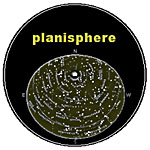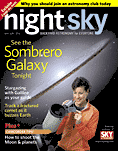BEFORE THE STARS COME OUT
Making the Most of Your First and
Every Night With Your Own Telescope
I'm sure you've heard it said that when planning and taking a trip "getting there is half the fun"! It's true! It's true of travel and it's true of getting and using your first telescope. It's even true of getting ready for each night of observing. In fact you can have almost as much fun on cloudy nights getting ready to make the most of the next time the stars come out!
There are a few simple guides and pieces of equipment which will make your entire observing career as enjoyable and rewarding as it can possibly be. Get to know them now and become experienced in their use before you choose your telescope. Do this, and your observing sessions will be filled with your own personal discoveries!

First get a "Star Wheel" or Planisphere, which will show the Sky over your head at any night-time moment any time of the year. The monthly star charts in stargazing magazines are good too. Either way you will notice how the stars move across the sky as the seasons progress, to set and be replaced by star patterns of the next season rising in the East. Use your star wheel (or monthly star chart) now to start learning the star patterns or "constellations". Knowing even a few constellations will allow you to guide your binoculars and soon your telescope towards planets, nebulae, and galaxies. A "desktop planetarium" program such as Starry Night Backyard for your home computer is a great idea too, though it may not be easily taken outdoors.
The desktop planetarium program will allow your computer screen to display the appearance of the sky for every direction you choose to face (Northeast, East, Southeast etc). It will name the stars and constellations and identify planets and other sky objects on demand. If you view the natural looking starry sky on your screen without labels you can practice using your planisphere to identify the stars and constellations. Then you will be ready to try the planisphere under the real night sky.
Next you need a soft red light flashlight so you can see your planisphere and other star charts outdoors without loosing your dark adaptation (the ability of your eyes to see faint objects). Nothing is more frustrating than being almost ready to see a faint star cluster with your own eyes only to dazzle them with a bright white light when you take a last peak at your chart!

Magazines for stargazers tell you about upcoming Sky Events to watch for and tell you how to find a never-ending supply of fascinating sights in the Sky. You can find them on a local newsstand or see the our Beginners Page for links to astronomical magazines. If you read one or more of these publications regularly you will always know of something else that you can go out and see with or without binoculars or a telescope. You will always be looking forward to the next clear night, and you will be understanding more and more about what you are seeing!

Binoculars (especially 7 x 35's, 7 x 50's, or 10 x 50's) are fun and easy to use and will show amazing sights, including galaxies up to 15 million light years away! I keep mine with me even when I am out with my telescope. When using binoculars you will notice that many stars too faint to be seen by your eyes alone come into view. That's where a "Star Atlas" is useful. An atlas divides the sky up into a number of areas or portions , each shown in much more detail on its own page or chart. After you can find some of the constellations an atlas will make it much easier to find and identify faint deep space objects such as star clusters, nebulae, and galaxies.
A Star Atlas is an entertaining companion on a cloudy night too. You can learn a lot about the sky by locating your next celestial targets on an atlas chart before you hunt for them in the sky.

Guidebooks to the Sky and background books on Astronomy make your stargazing nights much more exciting and successful. Look for them in your public library, in bookstores (physical or on-line). Books like "Nightwatch", by Terence Dickinson, tell you what to look for, how to find it, and how knowing what you are seeing makes it even more worthwhile. Look for books by David Levy too.
Now you can see that the excitement of being a "Sky Observer" starts well before you get your own telescope. You don't even have to wait for a clear night! You are "on your way" as soon as you take the first suggestion or two mentioned here! Enjoy!
Return to the Beginners Page

